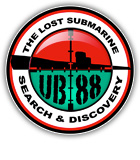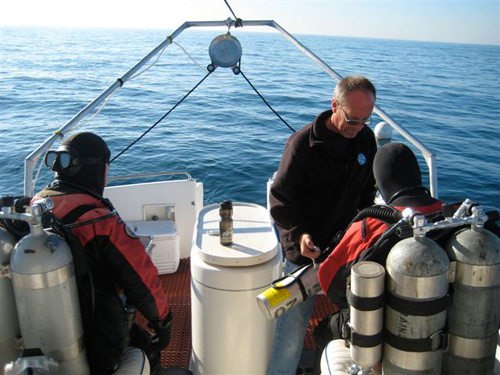
Capt. Ray Arntz assisting John Walker (left) and Kendall
Raine
before their first dive to the B-36 Peacemaker.
Photo by Pat Macha.
B-36
Dive Report
By Kendall Raine
December 2008
The weather was perfect after two weeks of storms. A warm
orange glow built from the east and the sea had a small
rolling swell. We left Mission Bay aboard
Sundiver II early
for the run out to the site of the crash of the largest
combat aircraft ever built. Nicknamed the Peacemaker,
the Convair B-36 was the first strategic bomber in the
American arsenal. In its day, no other aircraft of any
nation could fly as far with as large a payload as the
B-36. Conceived during World War II as a massive
conventional bomber, it was well suited to its early
cold war role as the ultimate deterrent against a Soviet
nuclear threat.
Despite claims since 2004 that the aircraft had been
located and dived by others, no evidence had ever been made
public supporting such claims. Dive reports from others
made us suspicious that what others were calling the B-36
was a rock pile with some scattered debris of something,
but not a massive aluminum and magnesium bomber. Based upon
our skepticism, we undertook a new search for the elusive
plane.
Once our team reviewed drop camera images of one of our
targets in October, we knew we had identified the wreck
site and that previous descriptions of the wreck’s
condition, it’s location and bottom features were
erroneous. We believed we would be the first sport divers
to visit her last resting place.
Aboard Sundiver was Captain Ray Arntz, aircraft
archaeologist Pat Macha, John Walker and I. John and I were
extremely excited about this dive. Having established the
wreck’s location six weeks ago, we’d been
chomping at the bit for a chance to visit the wreck.
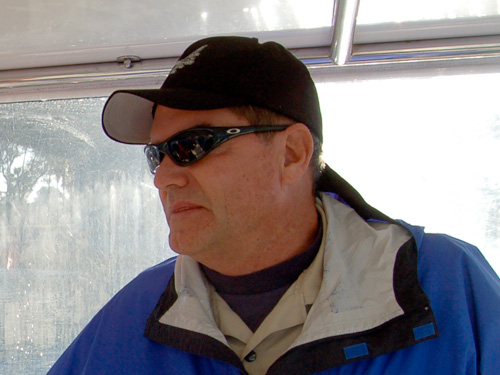
Aircraft archaeologist G. Pat Macha.
We arrived on site and dropped a weighted line in what we
believed was the center of the debris field. We knew the
wreck was severely broken up. We also expected substantial
portions of the fuselage and wings outer skin to have
corroded away. While the aluminum skin would have survived,
much of the B-36 covering was of magnesium. A revolutionary
material in 1952 terms of strength to weight ratio,
magnesium burned very easily and corroded very rapidly in
salt water. At the depth of the wreck, our scouting range
would be limited and swimming any distance at this depth
would bring the added penalties of increased gas
consumption and decompression stress. Our objective for
this dive was to shoot video of as many clearly
identifiable features of the B-36 as possible. First
amongst those would be the massive tires and propellers of
the B-36 who’s proportions were so beyond any other
aircraft then or now as to make identity a certainty. As
such, we expected to limit our swim to the area around the
middle of the massive aircraft so as to maximize our
chances of locating these features. We had drop camera
images of both targets, but scale was needed to make
identity definitive.
John and I descended the weighted line. We hoped for
similar conditions to those of our previous trip, but the
bottom was very dark. Visibility was no more than 15 feet
and a slight current ran over the wreck. I tied in a reel
to the up line and swam on a heading of 240 degrees toward
what we believed would be the middle of the fuselage. John
swam ten feet away to my left, the twin 35 watt HID lamps
of his video throwing a large field of light over the
wreck. From the beginning it was shocking how shattered the
wreckage was. The fuselage was flattened and broken in so
many pieces the largest section was perhaps fifteen feet
long. Despite this, I quickly passed over a large circular
opening in the top of the fuselage which was probably one
of the sighting blisters.

A hole in the aircraft skin where a plexiglas sighting
blister used to be installed.
Wiring ran the direction of our swim suggesting we were
following the contour of the fuselage. Almost everywhere
our lights illuminated vibrant purples, reds, oranges and
green gorgonians.
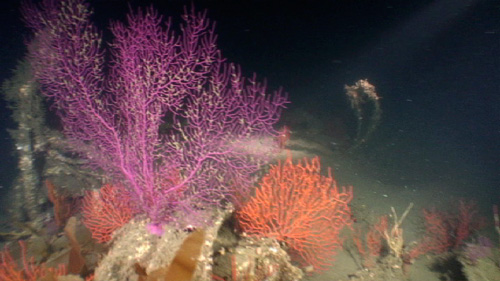
Beautiful gorgonians are abundant on the wreck.
Bright colored rock and flag fish scattered as we intruded
upon their home. After a five minute swim we came to a
patch of sand with no visible wreckage beyond. I turned
around and began to reel up the line. As I swam I noticed
mounds of debris off to my left. A dome shaped object
appeared in the darkness. It was semispherical except that
a portion of the dome was caved in. Though encrusted, the
dome looked to be made of plastic. Closer examination
revealed an aluminum base with handles visible protruding
from the bottom. This could only be one of the sighting
blisters used as part of the plane’s defensive system
and for observation/navigation-it fit in the hole in the
fuselage seen earlier. The dimensions and characteristics
of this object matched perfectly those of the B-36.
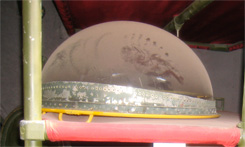
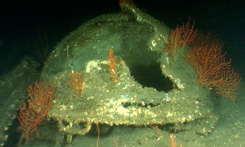
(Left) A plexiglas sighting blister from the last B-36
Peacemaker at the Pima Air & Space Museum, Tucson, AZ.
Photo by Gary Fabian. (Right) A damaged sighting blister
from the wreck site of the B-36 Bomber. Photo by John
Walker.
Continuing left, I came across more and more solid chunks
of aircraft including what looked like massive wing spars.
Large sections of rubber protruding from these spars
suggested portions of the fuel cells. As there was no
evident fire damage, I assumed I was over the left wing. My
suspicions were soon confirmed as out of darkness loomed
what was obviously one of the main landing gear struts. Its
massive length and diameter matched photographs. I looked
for the four massive tires which had to be nearby. The
first pair of these soon came into view. Nearly five feet
in diameter, these tires were the largest on any aircraft
of its time and rival those of today’s largest
commercial aircraft. They lay one on top of the other with
part of the wheel axle protruding from the top tire. I
immediately signaled John to shoot the image. As John and I
swam forward a few more feet another tire came into view.
With John”s light illuminating the scene I stretched
my arms wide across the diameter of the tire. My guess at
the time was that the diameter exceeded five feet. These
could not belong to any other aircraft known to have
crashed off Mission Beach.
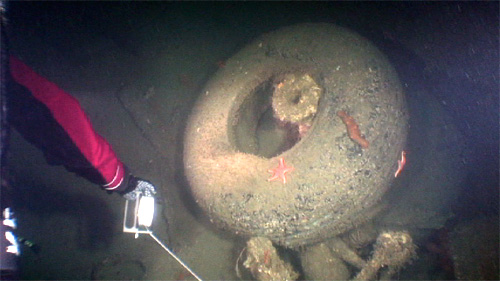
Kendall Raine swims past a pair of landing gear tires. An
axle can be seen protruding from the center of the tires.
Photo by John Walker.
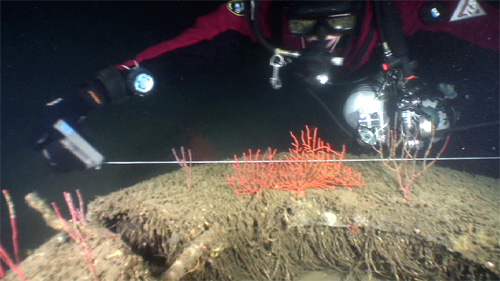
Kendall taking a measurement of another B-36 tire. Photo by
John Walker.
I then began a search for one of the six turbo charged
pusher mounted engines. What I really wanted was to get
scale on a propeller. Our bottom time was almost up and we
needed to turn for the up line. As we reached the up line I
cut the guideline from my reel rather than wasting time
reeling up. The penetration line was tied into the up line
and Ray would pull the whole mess up as he retrieved the up
line.
John and I started our long slow ascent back to light and
warmth. As we settled into the familiar routine of
decompression stops and gas switches, I shot a lift bag so
as to allow Ray to retrieve the up line. We completed our
deco drifting.
Ray and Pat eagerly welcomed us back. We quickly got back
aboard and loaded the video into Ray’s monitor. Pat
was fascinated with the video. Having spent much of his
adult life searching for and identifying military airplane
wrecks, Pat was able to offer possible identification to
numerous pieces of wreckage evident on the video. His
knowledge of the B-36 was nearly encyclopedic. When he saw
the landing gear struts and the sighting blister the case
was sealed. Seeing me draped over the tire was just icing
on the cake.
There is no doubt this was the wreck of a Convair B-36. The
only one to have crashed off Mission Beach and the plane so
heroically piloted by Dave Franks in those final minutes as
he bought with his life precious time for his crew to bail
out.
